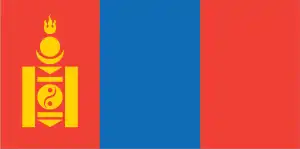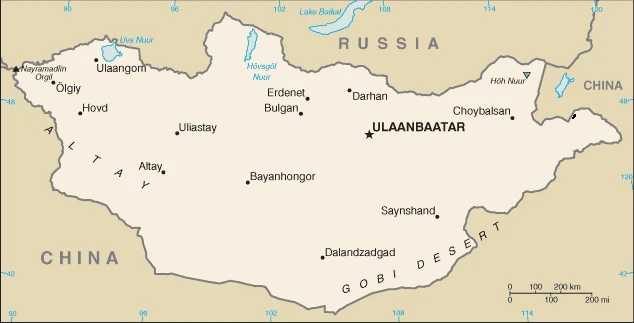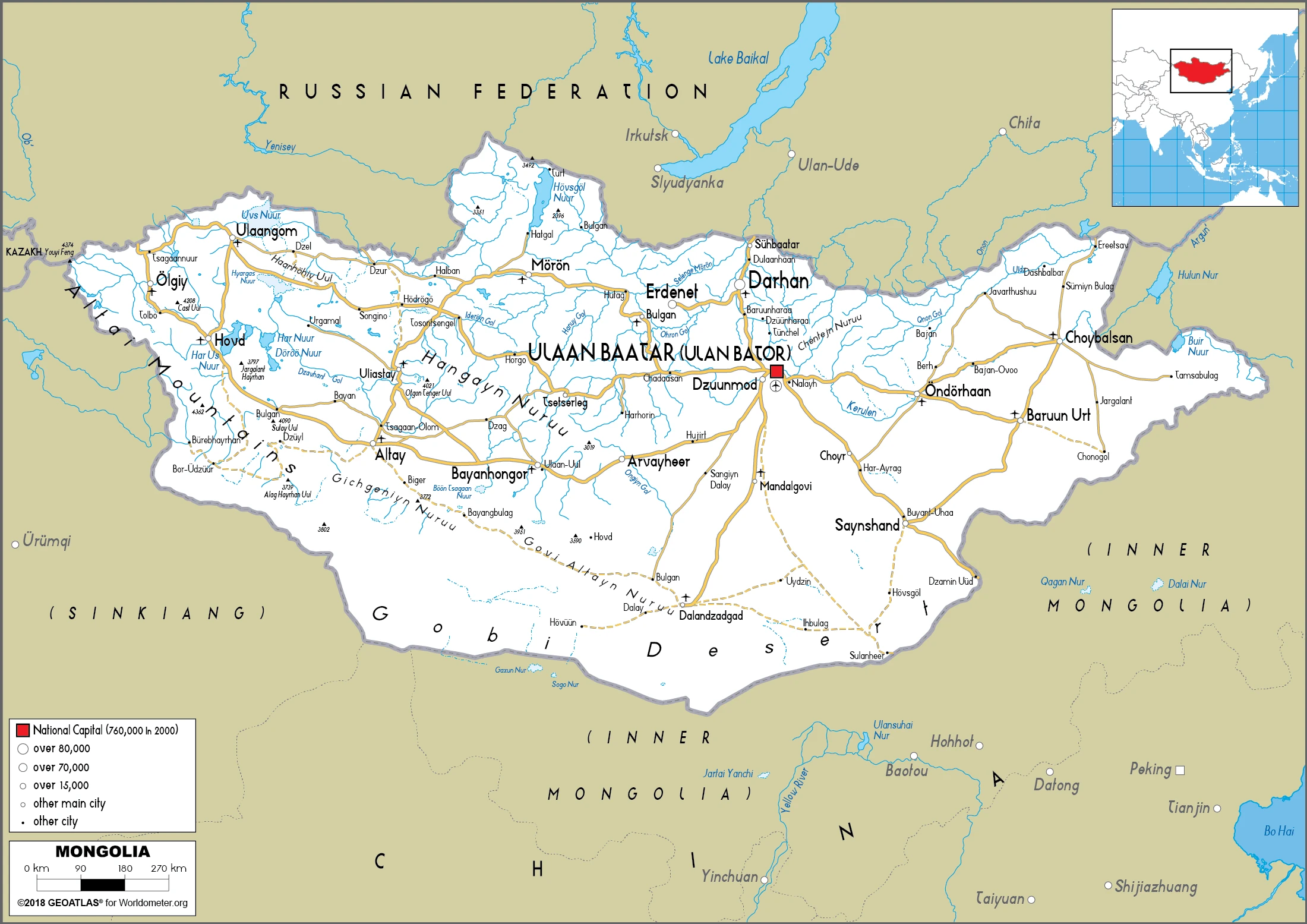Mongolia Google Maps is a site/tool that offers a wide range of map views (topographic, satellite, street view) and navigation options, with little effort on your part, yet efficiently. If you need to plan a trip to a new place like Mongolia, Google maps are available on desktop, mobile, or tablet. This Google maps and information page is dedicated to Mongolia, Asia (22 countries), showing its location, country facts, details about its capital city Ulaanbaatar, bordering countries like China, Russia, and plenty of other information which may be interesting when you visit this Asian state.
Quick links: Google Maps Mongolia, Ulaanbaatar Google maps, Driving Directions Mongolia, Printable Road Map.
About Mongolia in a nutshell

- Horseracing, wrestling, and archery are the national sports.
- Conventional short form of the name: Mongolia
- The conventional long form of the name: none
- Local long form: none
- Local short form: Mongol Uls
- Former name(s): Outer Mongolia, Mongolian Peoples Republic
- Etymology: the name means Land of the Mongols in Latin; the Mongolian name Mongol Uls translates as Mongol State.
- The legal system in Mongolia: civil law system influenced by Soviet and Romano-Germanic legal systems; constitution ambiguous on judicial review of legislative acts.
- Climate: Continental. Mild summers and long, dry, very cold winters, with heavy snowfall. Temperatures can drop as low as 22°F (30°C).
- The national symbols are soyombo emblem; national colors: red, blue, yellow.
- Internet TLD: .mn
Squeezed between Russia and China, this ancient state was the largest contiguous empire on Earth during the reigns of Genghis Khan and Kublai Khan. Dominated by temperate steppe and desert, the country’s harsh winters mean that tourists visit mostly only in the summer months. More extensive forests are found on the slopes of the 4000m high mountains of the Mongol Altai and the Hangai, which are covered in perpetual snow, on the western and northern fringes of the country. A magnificent glacier descends from the Tavanbogd Uul peak on the western triple border, and the valleys and basins are dominated by desert, salt, and freshwater lakes. The largest of these is Lake Hövsgöl, which contains 2% of the world’s freshwater. The southern third of Mongolia is covered by the Gobi, the largest semidesert in the temperate belt. But the seemingly barren desert of pebbles and stones grows just enough grass to support nomadic sheep, goats, and camels.
The Mongolian wasteland is the ancestral home of the ancient Asian wild horse, the takhi (Przewalski’s). Now, only the protected areas are home to the wild descendants of Genghis Khan’s back horses. Held on the anniversary of the Mongol Revolution of 1921, the Naadam Festival, held every year from 11-13 July, is a celebration of the three Mongolian national sports of wrestling, archery, and horse racing. The two World Heritage Sites are a good representation of Mongolia’s attractions: the northernmost basin of Inner Asia, the Uvs Nuur, encompasses the belly-named undrained salt lake and 12 protected areas with diverse steppe ecosystems. The cultural heritage of the Orhon Valley, with its archaeological remains, the ruins of the Karakorum, the capital of the Mongol Empire in the 13th and 14th centuries, and its religious centers, symbolizes the continuity of the nomadic pastoral society that survives today.
Background
The peoples of Mongolia have a long history under several nomadic empires dating back to the period of the Xiongnu in the 4th century B.C. The name Mongol goes back to at least the 11th century A.D. The most famous Mongol, TEMÜÜJIN (aka Genghis Khan), emerged as the ruler of all Mongols in the early 1200s. By the time of his death in 1227, he had created a Mongol Empire that extended across much of Eurasia through conquest. His descendants, including ÖGÖDEI and KHUBILAI (aka Kublai Khan), continued military campaigns of conquest, taking control of Eastern Europe, the Middle East, and the rest of China, where KHUBILAI established the Yuan Dynasty in the 1270s. The Mongols attempted to invade Japan and Java before their empire broke apart in the 14th century. In the 17th century, Mongolia fell under the rule of the Manchus of the Chinese Qing Dynasty. Following the collapse of the Manchus in 1911, Mongolia declared its independence, achieving it with help from the Soviet Union in 1921. Mongolia became a socialist state (the Mongolian Peoples Republic) in 1924.
Following independence and until the collapse of the Soviet Union in 1989, the country was a Soviet satellite state and heavily reliant on economic, military, and political assistance from Moscow. The period also was marked by periods of purges, political repression, economic stagnation, and tensions with China. Mongolia peacefully transitioned to an independent democracy in 1990. In 1992, it adopted a new constitution and established a free market economy. Since the country’s transition, it has conducted six presidential and eight legislative elections as of 2020. Throughout the period, the ex-communist Mongolian Peoples Revolutionary Party (MPRP) – which took the name Mongolian Peoples Party (MPP) in 2010 – have competed for political power with the Democratic Party (D.P.) and several other smaller parties, including a new party formed by former President ENKHBAYAR, which confusingly adopted for itself the MPRP name. In the 2016 parliamentary elections, the MPP won overwhelming control of the Parliament over the D.P., which had overseen a sharp decline in Mongolia’s economy during its control of the Parliament in the preceding years. Mongolians elected a D.P. member, Khaltmaa BATTULGA, as president in 2017. The June 2020 parliamentary elections left the MPP with continued dominant control of the Parliament. Mongolia maintains close cultural, political, and military ties with Russia, while China is its most significant economic partner. Mongolia’s foreign relations are focused on preserving its autonomy by balancing relations with China and Russia and its other significant partners, Japan, South Korea, and the US.
Geography
A mountainous steppe plateau in the north, with lakes in the north and west. The desert region of the Gobi dominates the south.

Landlocked between Russia and China, Mongolia is a vast, isolated, and sparsely populated nation. Over two-thirds of the country is part of the Gobi Desert.
This state is located in Northern Asia, between China and Russia, under the coordinates of 46 00 N, 105 00 E, covering an area of 1,564,116 sq km with a coastline of 0 km (landlocked country). Mongolia is slightly smaller than Alaska, more than twice the size of Texas.
Mongolia has 8,082 km of land boundaries in total and borders (2 nations): China, 4630 km, Russia, 3452 km.
Vast semidesert and desert plains, grassy steppe, mountains in west and southwest, gobi desert in south-central, with Nayramadlin Orgil (Khuiten Peak) 4,374 m as the highest point of Mongolia, while Hoh Nuur 560 m as the lowest point, causing a mean elevation at 1,528 m throughout the country. With a total of 1,564,116 sq km, Mongolia has 1,553,556 sq km of land and 10,560 sq km of water surface area.
Major water bodies in the country: Hovsgol Nuur – 2,620 sq km; Har Us Nuur – 1,760 sq km; (freshwater lake), Uvs Nuur – 3,350 sq km; Hyargas Nuur – 1,360 sq km (saltwater lake) while the major rivers are: Amur (shared with Russia and China) – 4,444 km.
landlocked; strategic location between China and Russia
The climate in Mongolia is as follows: Desert, continental (large daily and seasonal temperature ranges).
When you visit Mongolia, the natural hazards shall be considered: Dust storms; grassland and forest fires; drought; zud, which is harsh winter conditions.
The following major health-threatening issues shall be considered when visiting Mongolia: none.
Current environmental issues affecting the Mongolian people: limited natural freshwater resources in some areas; the burning of soft coal in power plants and the lack of enforcement of environmental laws leads to air pollution in Ulaanbaatar; deforestation and overgrazing increase soil erosion from wind and rain; water pollution; desertification and mining activities harm the environment.
Google Maps Mongolia
The capital and other divisions
Capital city: Ulaanbaatar found under the coordinates 47 55 N, 106 55 E, applying the time zone UTC+8 (13 hours ahead of Washington, DC, during Standard Time), using the following daylight saving time: +1hr begins last Saturday in March; ends last Saturday in September.
Ulaanbaatar is Mongolia’s capital city. Its population is about 1 million, and it is the capital of Mongolia. It was initially named Urga and was renamed in 1924 when the revolution took place in Mongolia. If you are visiting Ulaanbaatar, you can check out the Mongolian National Museum, visit Sükhbaatar Square and Sukhbaatar Square, explore the traditional markets, and get a taste of life in Mongolia.
Mongolia became independent on 29 December 1911 (independence declared from China; in actuality, autonomy was attained); 11 July 1921 (from China), and its national holiday is Naadam (games) holiday (commemorates independence from China in the 1921 Revolution), 11-15 July; Constitution Day (marks the date that the Mongolian Peoples Republic was created under a new constitution), 26 November (1924).
Administrative divisions: 21 provinces (aymguud, singular – aymag) and 1 municipality (singular – hot); Arhangay, Bayanhongor, Bayan-Olgiy, Bulgan, Darhan-Uul, Dornod, Dornogovi, Dundgovi, Dzavhan (Zavkhan), Govi-Altay, Govisumber, Hentiy, Hovd, Hovsgol, Omnogovi, Orhon, Ovorhangay, Selenge, Suhbaatar, Tov, Ulaanbaatar, Uvs.
People and society
Mongolia was unified by Genghis Khan in 1206 and was later absorbed into Manchu China. A majority of ethnic Mongolians live in China in Inner Mongolia. Tibetan Buddhism dominates. The traditional, nomadic way of life has been eroded as urban migration continues, spurred by ferocious winters, known as zud, which can devastate the rural economy.
The population in Mongolia is 3,198,913 (July 2021 estimate). Note: Mongolia is one of the least densely populated countries in the world (2 people per sq km); twice as many ethnic Mongols (some 6 million) live in Inner Mongolia (Nei Mongol) in neighboring China, with an average of 0.93% (2021 estimate) change. That means Mongolia is the No. 134 in the world’s populated rank list. With an average of 29.8 years median age (28.8 years for males and 28.8 years for women), Mongolia ranks No. 126 on the globe’s median age rank list.
The people living in this country are the Mongolian(s) (noun) or Mongolian (adjective) and belong mainly to the following ethnic groups: Khalkh 83.8%, Kazak 3.8%, Durvud 2.6%, Bayad 2%, Buriad 1.4%, Zakhchin 1.2%, Dariganga 1.1%, other 4.1% (2020 estimate).
They speak Mongolian 90% (official language) (Khalkha dialect is predominant), Turkic, Russian (1999) languages and practice the following religions: Buddhist 53%, Muslim 3%, Shamanist 2.9%, Christian 2.2%, other 0.4%, none 38.6% (2010 estimate).
We can conclude the following about the population in Mongolia: Sparsely distributed population throughout the country. The capital of Ulaanbaatar and the northern city of Darhan support the highest population densities. In Mongolia, we are talking about 68.8% (2021) of the total population lives in cities, and most of them reside in the following municipalities: 1.615 million, Ulaanbaatar (capital city) (2021).
Industry
Rich deposits of oil, coal, copper, uranium and other minerals remain largely untapped. Cashmere exports. Democracy, from 1990, brought a shift toward a market economy and rising poverty. State involvement in mining is an issue. Agriculture uses a third of the workforce, mainly as herders.
Foreign direct investment in Mongolia’s extractive industries based on extensive deposits of copper, gold, coal, molybdenum, fluorspar, uranium, tin, and tungsten – has transformed Mongolia’s landlocked economy from its traditional dependence on herding and agriculture. Exports now account for more than 40% of GDP. Mongolia depends on China for more than 60% of its external trade – China receives some 90% of Mongolia’s exports and supplies Mongolia with more than one-third of its imports. Mongolia also relies on Russia for 90% of its energy supplies, leaving it vulnerable to price increases. Remittances from Mongolians working abroad, particularly in South Korea, are significant., Soviet assistance, at its height, one-third of GDP, disappeared almost overnight in 1990 and 1991 at the time of the dismantlement of the USSR. The following decade saw Mongolia endure deep recessions because of political inaction, natural disasters, and strong economic growth because of market reforms and extensive privatization of the formerly state-run economy.
The country opened a fledgling stock exchange in 1991. Mongolia joined the WTO in 1997 and sought to expand its participation in regional economic and trade regimes. Growth averaged nearly 9% per year in 2004-08, primarily because of high copper prices globally and new gold production. By late 2008, Mongolia was hit by the global financial crisis, and Mongolia’s real economy contracted 1.3% in 2009. In early 2009, the IMF reached a $236 million Stand-by Arrangement with Mongolia, and it emerged from the crisis with a more robust banking sector and better fiscal management. In October 2009, Mongolia passed long-awaited legislation on an investment agreement to develop the Oyu Tolgoi (O.T.) mine, the world’s largest untapped copper-gold deposit. However, a dispute with foreign investors developing O.T. called into question the attractiveness of Mongolia as a destination for foreign investment. This caused a severe drop in FDI, and a slowing economy, leading to the dismissal of Prime Minister Norovyn ALTANKHUYAG in November 2014. The economy had grown more than 10% per year between 2011 and 2013 – mainly on the strength of commodity exports and high government spending – before slowing to 7.8% in 2014 and falling to the 2% level in 2015. Growth rebounded from a brief 1.6% contraction in the third quarter of 2016 to 5.8% during the first three quarters of 2017, primarily due to rising commodity prices. The May 2015 agreement with Rio Tinto to restart the O.T. mine and the subsequent $4.4 billion finance package signing in December 2015 stemmed from the loss of investor confidence.
The current government has made restoring investor trust and reviving the economy its top priority but has failed to invigorate the economy due to the significant drop-off in foreign direct investment, mounting external debt, and a sizeable budget deficit. Mongolia secured a $5.5 billion financial assistance package from the IMF and a host of international creditors in May 2017, which is expected to improve Mongolia’s long-term fiscal and economic stability as long as Ulaanbaatar can advance the agreements on difficult contingent reforms, such as consolidating the government’s off-balance-sheet liabilities and rehabilitating the Mongolian banking sector.
Mongolia is rich in the following natural resources: Oil, coal, copper, molybdenum, tungsten, phosphates, tin, nickel, zinc, fluorspar, gold, silver, iron.
The main industrial sectors are typically construction and construction materials; mining (coal, copper, molybdenum, fluorspar, tin, tungsten, gold); oil; food and beverages; the processing of animal products, cashmere, and natural fiber manufacturing.
The country’s export sectors are robust in coal, copper, gold, iron, crude petroleum (2019), partnering with these nations: China 81%, Switzerland 9% (2019). The export trade resulted in $7.65 billion. Note: Data are in current year dollars (2020 estimate). A global rank of the export values resulted in Mongolia’s position of 108.
Land use in Mongolia: 7% (2018 estimate) forest, 20% (2018 estimate) other.
The arable land area is 0.4% (2018 estimate), and the agricultural land is 73% (2018 estimate). Land use for permanent crops 0% (2018 estimate), permanent pasture 72.6% (2018 estimate). The sum of the area of the irrigated land is 840 sq km (2012).
The main agro-industrial products of Mongolia are milk, wheat, goat milk, potatoes, mutton, sheep milk, beef, goat meat, horse meat, carrots/turnips.
The country typically needs to import: refined petroleum, cars, delivery trucks, construction vehicles, aircraft (2019), partnering with the following nations: China 31%, Russia 29%, Japan 10%, South Korea 5% (2019) in a sum value of $7.34 billion. Note: data are in current year dollars (2020 estimate) $9.25 billion. Note: data are in current year dollars (2019 estimate) $8.48 billion. Note: data are in current year dollars (2018 estimate). This sum value on the global ranking list of imports resulted in Mongolia 124.
Mongolia Driving Directions
In this post, you learned about Mongolia, Northern Asia, between China and Russia. We published some basic information about its capital Ulaanbaatar, and the Mongolian nation.
Are you interested in visiting Mongolia and looking for driving directions? Click here to plan your route, or see a printable road map of Mongolia below for an overview of the route network.
Printable map of Mongolia
Did you know about Mongolia?
Mongolia is the 19th largest country globally, with 3,2 million people. Mountains cover One-third of its land, with one of the lowest population densities. The capital city, Ulaanbaatar, lies in the center of Mongolia, and it is home to more than 1,6 million people.
The country’s name comes from the Mongolian word “Mongol,” meaning “The Land of Blue Sky. Mongolia has been under Chinese influence for many years, but it remains relatively free of Chinese influence today.
After virtually visiting Mongolia, you may also be interested in the neighboring countries: China, Russia.
If you liked our Google map and Mongolia information page,
please share it with others or save the link https://www.drivingdirections.net in your bookmarks.

